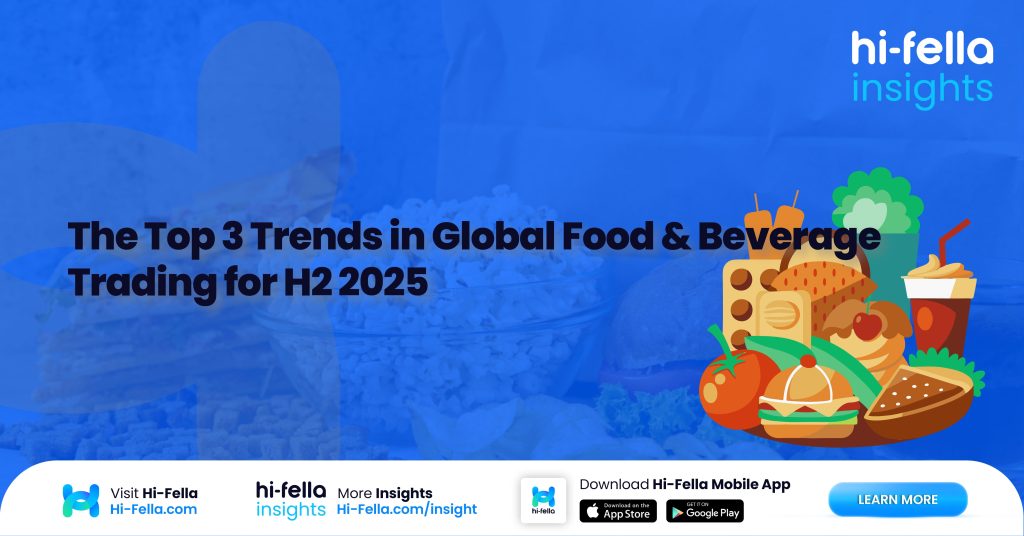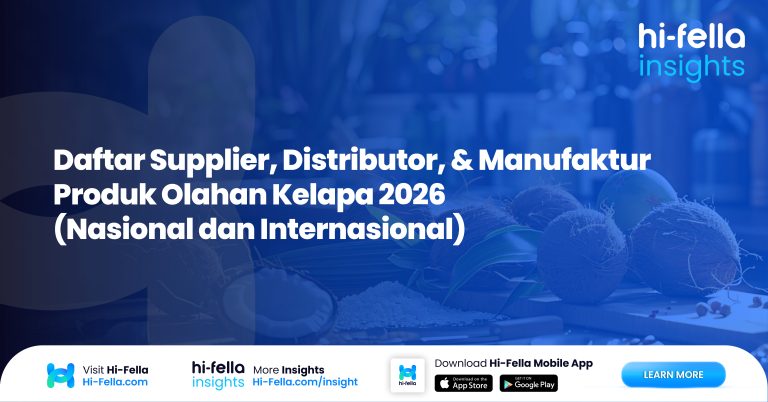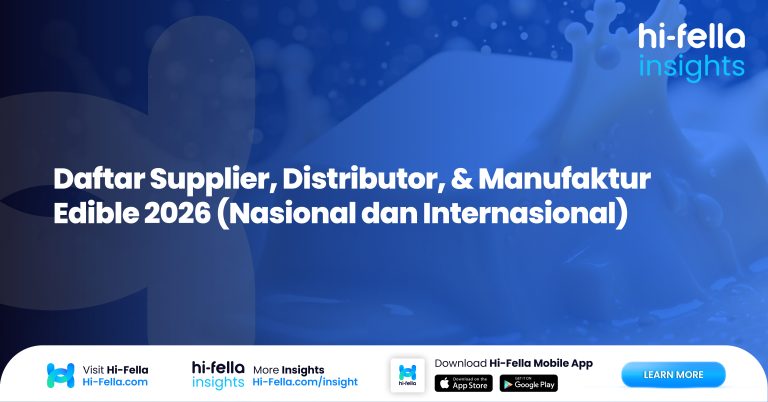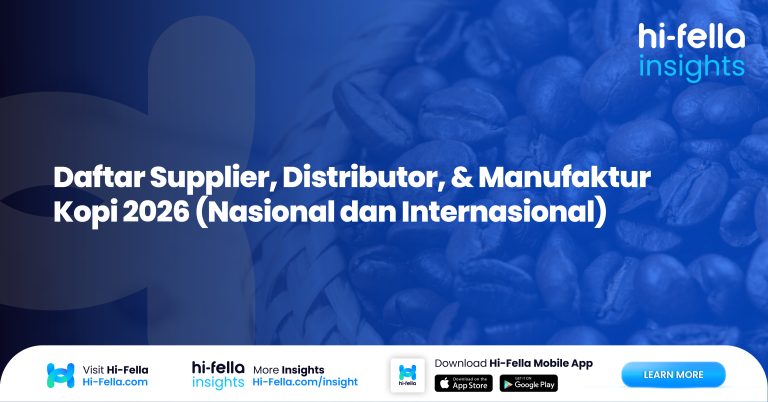In today’s fast-evolving world of global food and beverage F&B trade, staying ahead of the curve is more critical than ever. As we approach the second half of 2025, several key trends are emerging that are reshaping the industry landscape. These shifts are not only driven by changing consumer preferences but also by global regulatory pressures, technological advancements, and environmental challenges.
For F&B exporters and traders, adapting to these trends will be essential to staying competitive and profitable in the global marketplace. In this article, we will explore the top three trends in global food and beverage trading for the remainder of 2025.
Table of Contents
Surge in Demand for Sustainable and Traceable Ingredients for F&B Trade
One of the most significant shifts in the global F&B trade is the increasing demand for sustainable and traceable ingredients. Consumers are more conscientious about where their food comes from and how it is produced. This heightened awareness is being driven by various factors, including new environmental, social, and governance (ESG) regulations, as well as an overall desire for transparency in food sourcing.
The Role of ESG Regulations
As governments worldwide enforce stricter ESG regulations, businesses must adapt quickly to avoid penalties and meet evolving consumer expectations. The European Union (EU), North America, and Japan are particularly leading the charge in promoting sustainability in the food sector. For example, the EU’s European Due Diligence Regulation (EUDR), which is expected to come into effect in the near future, will require companies to trace the origin of their products, ensuring they meet sustainability and human rights standards. Similarly, carbon labelling is gaining momentum, allowing consumers to make more eco-friendly choices by understanding the environmental impact of their purchases.
The Rise of Eco-Labelling and QR-Code Traceability
For F&B businesses, these regulations have become an opportunity to showcase their sustainability efforts. Sustainable food products, such as organic cocoa, regenerative coffee, and sustainably farmed seafood, are becoming more sought after, especially in markets like the EU, Japan, and North America. To meet this growing demand, companies are increasingly adopting tools like QR-code traceability, which enables consumers to scan products and access detailed information about the product’s origin, production process, and environmental impact.
These changes are reshaping the global F&B trade, as buyers prioritize traceable, responsibly sourced products. For example, sustainably farmed seafood has gained popularity in Europe due to both increasing consumer demand for sustainable options and stricter regulatory standards regarding fishing practices. Similarly, regenerative coffee and organic cocoa are becoming more important, as global consumers, especially those in Europe and North America, are willing to pay a premium for products that contribute to a more sustainable future.
The Rise of Functional & Wellness Food Exports
The global interest in health and wellness has significantly influenced the F&B trade, with consumers increasingly seeking products that promote immunity, digestive health, and overall well-being. As part of this trend, functional and wellness foods are seeing a surge in demand, with many products geared toward boosting immunity or supporting gut health. This rising demand for health-focused food products is reshaping the global export landscape, especially for emerging markets in Asia and Latin America.
Key Functional Food Exports
Among the most popular functional food exports are turmeric-based beverages, adaptogen teas, mushroom snacks, and fermented superfoods. These products have gained significant attention due to their perceived health benefits, such as improving immune function, reducing inflammation, and supporting digestion. For example, turmeric-based beverages, widely popular in Southeast Asia, are making their way into international markets like the US and Europe, where interest in natural remedies and immunity-boosting ingredients is high.
Markets in Latin America, particularly in countries like Brazil and Peru, are also seeing increased export activity of adaptogenic foods like teas infused with herbs such as ashwagandha, known for their stress-relieving properties. Similarly, fermented superfoods like kimchi, kefir, and kombucha are gaining traction among health-conscious consumers, particularly in North America and Europe, where probiotics are valued for their gut-health benefits.
According to Euromonitor and Mintel reports, the functional food sector is expected to grow at a faster pace than traditional food categories. With greater awareness of the link between diet and health, F&B traders are pivoting to meet the demand for plant-based, functional foods. Products from Asia and Latin America are well-positioned to take advantage of this trend, as they can offer innovative wellness food solutions that align with shifting consumer preferences.
AI-Powered Trade Matching and Digital Showcases Are Changing the Game
Artificial Intelligence (AI) is quickly becoming a game-changer in global food and beverage trading, revolutionizing traditional trade flows and processes. By leveraging AI-powered tools, F&B exporters are now able to tap into predictive demand mapping, smart product recommendations, and automated trade matchmaking, streamlining how products are introduced to new markets and connecting buyers and suppliers faster than ever.
Predictive Demand Mapping and Smart Product Recommendations
AI tools can analyze large datasets to predict demand trends and market preferences, enabling F&B exporters to make informed decisions about where to focus their efforts. For instance, predictive demand mapping can highlight emerging markets for turmeric-based beverages or plant-based protein products, allowing exporters to strategically target buyers in regions with the most potential. Smart product recommendation tools can also suggest which products are most likely to appeal to specific buyers, further enhancing trade efficiency.
Virtual Private Showcases and Smart Translation Tools
Another major development in F&B trade is the use of virtual private showcases and smart translation tools on B2B platforms. Virtual showcases allow F&B exporters to present their products to potential buyers from across the globe without attending costly expos or trade shows. Whether in the UAE, South Korea, or Germany, exporters can showcase their products and interact with potential buyers in real-time, breaking down geographical and logistical barriers.
Smart translation tools also make it easier for traders to communicate with international buyers, automatically translating messages and product descriptions into various languages. This technology is helping F&B exporters expand their reach and make the trade process more efficient and accessible, particularly in regions where language barriers could have previously hindered negotiations.
Export Challenges: Climate, Logistics, and Compliance Risks
While global food and beverage trading continues to grow, there are several challenges that exporters must navigate. Climate-induced crop disruptions, shipping delays, and compliance risks are becoming increasingly important factors that can impact trade flows and product availability.
Climate-Induced Crop Disruptions
Climate change is leading to unpredictable weather patterns that disrupt crop yields, particularly in regions dependent on specific climates for certain ingredients. For example, unpredictable rainfall patterns and temperature fluctuations can affect the production of key crops like cocoa, coffee, and spices. As a result, exporters must adapt by diversifying their sourcing strategies, exploring multiple-origin sourcing, and creating more resilient supply chains.
Shipping and Logistics Challenges
Shipping disruptions, especially in high-risk areas like the Red Sea, have also impacted global trade in recent years. These logistical challenges, combined with labor shortages in key ports, can cause delays in product deliveries and affect trade timelines. Companies are responding by shifting to just-in-time fulfillment models, improving inventory management, and leveraging technology to ensure a smoother supply chain process.
Compliance Risks
As regulations continue to tighten in both emerging and developed markets, exporters must be aware of changing compliance requirements. This includes stricter labelling regulations, particularly in markets like China, where labeling and ingredient disclosure rules are becoming more stringent. Exporters must ensure they are up-to-date with all relevant regulations to avoid costly fines and disruptions to their trade.
Join Hi-Fella Today!
With the rapidly changing dynamics of the global food and beverage trade, staying ahead of trends and market shifts is critical. Whether you’re exporting functional drinks from Thailand or sourcing organic spices from Sri Lanka, being connected to the right data and partners is key to success. Hi-Fella is the global platform that connects verified F&B traders, enabling them to showcase their products, connect directly with buyers, and respond to global market trends quickly.
Hi-Fella offers F&B exporters access to real-time insights, efficient trade tools, and a global network of trusted partners. By joining Hi-Fella, you can take your food and beverage trading business into the next frontier and stay ahead of emerging trends in sustainability, health-focused foods, and digital trade.








